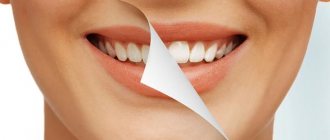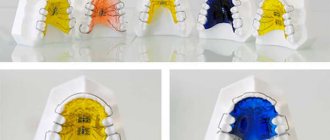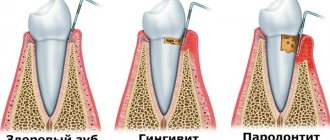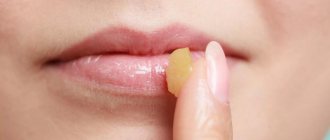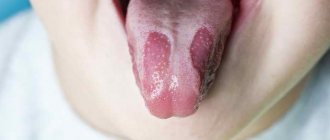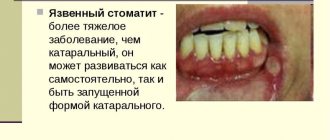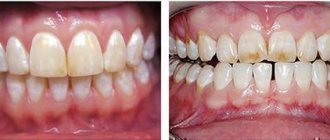Why do they appear?
Dentists will name many reasons for the appearance of a cosmetic defect. These include:
- a change in the color of plaque over time, which is almost always present on the teeth, but is normally removed with a brush and paste twice a day;
- heredity;
- diseases of the gastrointestinal tract;
- the presence of old fillings made of amalgam;
- smoking;
- long-term wearing of braces, due to which the areas where the structure adheres to the enamel are poorly cleaned;
- when treating deep caries, the doctor did not clean the canals enough;
- fluorosis;
- enamel hypoplasia (more often in children);
- basal caries (dark spots are localized near the gums, where the neck of the tooth passes);
- dysbacteriosis;
- erasing of enamel due to age-related changes, malocclusion (over the years, some shrinkage of the gums occurs, the neck is exposed, and during chewing the teeth rub against each other);
- use of tetracycline antibiotics.
Brown dark spots are usually initially white or yellowish.
They darken if you do not pay attention to them in time. In some cases, the dentist will clean your teeth using the chosen professional method, in others you will have to take a closer look at your health - get examined to find out if there is a more deeply hidden reason.
Caries
Dark spots on a child’s teeth are a problem that requires a separate discussion. What is the triggering factor in this case? Enamel loses its natural whiteness if:
- the mother was ill while carrying the baby - in this case, the teeth are already unhealthy, and the color of the first milk teeth can be very different from snow-white;
- lack of moisture in the baby’s body, which contributes to the growth of bacteria in the oral cavity;
- excess iron in food;
- improper absorption of calcium (pay attention to whether nails are peeling, whether hair is growing well);
- enamel hypoplasia;
- one of the first stages of caries is observed;
- The doctor diagnosed Priestley's plaque.
Even a one-year-old infant's teeth sometimes darken. Are there spots? First of all, consult a doctor.
Priestley's Raid
Many people believe that there is no point in paying extra attention to baby teeth - they will fall out anyway. But if you have diseased teeth, your gums will also not be able to remain healthy for long. Gingivitis and stomatitis are possible. In addition, bacteria firmly establish themselves in the child’s mouth and will immediately damage permanent teeth as soon as they erupt.
And don’t forget: diseased teeth are a source of infection, which spreads throughout the body through the blood and lymph. A child whose teeth are affected by caries is more likely to experience pharyngitis, tonsillitis, rhinitis and sinusitis. Pediatricians often find enlarged tonsils in such children.
The same applies to adults. Only his body can cope with bacteria for a long time, since his immunity is stronger. But at the slightest weakening, for example, hypothermia, expect laryngitis, tonsillitis or sore throat.
Treatment of fissure and superficial caries
When a fissure spot appears on the enamel due to the development of caries, such a unit requires urgent therapeutic measures. Treatment of initial caries with superficial damage to the enamel begins with cleaning and filling the pathological organ. To prevent the disease from progressing, regular monitoring of units that are registered with the dentist is necessary.
If the anomaly affects the pulp, then you can try to eliminate the inflammatory process while preserving the nerve. There are cases when it is impossible to preserve the nerve. In such a situation, extirpation is used and only after that a filling is placed. As you can see, treatment of tooth pulpitis is more complex. Of course, a non-living unit will collapse after some time. But, if the patient strictly follows the doctor’s recommendations, the operational period of such an organ will increase significantly.
Color of dark spots
Fortunately, not every dark spot indicates serious problems in the body. Let's look at individual cases, presenting them in table form for convenience.
| Spot color | Reason for appearance | Treatment method |
| Brown, uneven, on several teeth at once | Smoker's plaque | Get professionally cleaned and quit smoking |
| Gray, uneven | Enamel hypoplasia | Teeth are coated with special compounds to strengthen the enamel. Treatment – only in the dentist’s office |
| Yellow-brown, dark brown | The initial stage of caries, when the white spot that appears darkens | Treating the stain and covering the area with a filling |
| Brown | Pigmentation due to the use of coloring products. Porous enamel | Professional teeth cleaning |
| Black | Caries, diseases of internal organs | Treatment of caries, examination and treatment of gastrointestinal diseases |
| Yellowish-dark plaque in a child | Poor oral hygiene | Teaching your child how to properly brush their teeth and monitoring their daily routine |
| Black plaque in a child | The presence of special bacteria - Priestley's plaque | No special treatment is prescribed, observation. Plaque usually disappears spontaneously |
The color of dark spots also depends on the individual characteristics of the organism. Perhaps you think that you have caries, but the dentist, after conducting an examination, diagnoses only age-related changes or darkening of the pulpless tooth.
Stages of caries
In any case, consulting a doctor is mandatory.
How to remove black stains on teeth
In itself, the treatment of black spots is nothing more than symptomatic therapy. An experienced dentist, who is required in this case, will help determine the cause. After this, either whitening, targeted treatment for caries, or mechanical removal of stains will be performed. In any case, they will not go away on their own, but they can even lead to the development of the disease. Teeth whitening, polishing and other measures to eliminate black spots and additional treatment/elimination of the cause are necessary.
The following preventive measures and folk remedies will help prevent the appearance of black spots:
- careful adherence to oral hygiene, brushing your teeth twice a day - in the morning and at night;
- rinse your mouth with calendula or chamomile after you eat something;
- purchase whitening products at the pharmacy and regularly treat your teeth with them;
- use dental floss to remove food debris between your teeth;
- change your lifestyle in favor of quitting smoking and alcohol, as well as reducing the dose of coffee.
We invite you to familiarize yourself with Leukoplakia - causes, symptoms, diagnosis and treatment
At the dentist's office
It is impossible to get rid of plaque without a preliminary inspection. Therefore, first you will come for an appointment, during which the doctor will determine the reason for the change in the shade of the enamel. He will then recommend a method to remove stains and give you a sparkling white smile.
If carious changes are diagnosed, the teeth will have to be treated, otherwise a cavity will appear in place of the stain, which is filled with pathogenic microorganisms.
The next stage is pulpitis, when the doctor will need to perform surgery to remove the diseased nerve.
Do not bring the situation to this stage - cure caries at the spot stage.
Caries in the spot stage
If the stains are caused by other reasons, the doctor will suggest professional cleaning. Methods used:
- ultrasonic cleaning;
- laser whitening;
- photobleaching;
- chemical bleaching;
- application of Air Flow.
Dentists consider ultrasonic cleaning to be the safest method. Using a special apparatus, the doctor will go over all surfaces of the teeth, including the inside, interdental spaces, and cervical areas. It will remove both soft and hard plaque - as a result, the teeth will become lighter and eliminate the danger of developing caries.
Sometimes the gums are damaged during the cleaning process, especially if there were a lot of dark spots in the cervical area. Don't be alarmed if your gums bleed slightly. Use Metrogyl Denta gel for 7 days after cleaning - it will quickly heal the wounds and make the gum tissue strong and healthy.
Laser whitening simultaneously removes plaque and brightens teeth. By the way, the principle of operation in this case is similar to photobleaching. A gel is applied to the teeth and activated by a laser beam (or lamp). Oxygen molecules are released, which clean the teeth and heal the oral cavity.
Procedure stage
Chemical bleaching is not used very often. The reason is this: the composition that is used to coat teeth to give them a light shade is quite aggressive. It penetrates the enamel and dentin tissue and can weaken them, destroying the natural protective barrier. Another disadvantage of this procedure: the risk of accidental damage to the gums. Of course, they will be closed first, but it is still impossible to completely eliminate the possibility of aggressive substances getting on the gum tissue.
Doctors warn about these pitfalls.
Does your dentist suggest using Air Flow? Try it! A time-tested technique actively used today. A cleaning powder is applied to the teeth along with a powerful stream of water, mechanically washing away all deposits: both hard and soft. Afterwards, the doctor polishes the teeth and applies a paste to them to soothe irritated gums.
Take a look at the photos before and after whitening: impressive?
Before and after whitening
The tooth under the filling hurts. What does the treatment method depend on?
When treating secondary dental caries, the dentist must choose the right tactics: either correct the filling, or remove it and refill the cleaned and treated cavity. In some cases, after removing the affected tissue, the cavity turns out to be so large that to restore the dental crown it is necessary to use special inlays or cover the treated tooth with a crown made from an impression.
- There is no need to remove the entire filling if the chewing surface in the area of only one of the walls of the carious cavity has suffered from secondary caries. Necrotic tissue is removed, a cavity is formed and filled with the same filling material. Then the filling is ground and polished.
- If the infection has spread to several sides or around the entire filling, it is removed, the cavity is formed and treated, and the filling is refilled.
At home
You can remove dark spots at home, but responsibility for the results falls on the shoulders of the patient.
The methods are as follows.
Recipe No. 1
Try treating your teeth this way a couple of times a week. But keep in mind that with thin, fragile enamel, the method is contraindicated: its surface can be easily damaged.
- Crush an activated carbon tablet in a teaspoon.
- Apply the resulting powder to the brush.
- Brush your teeth as if it were toothpaste.
- Rinse your mouth.
- Brush your teeth with the toothpaste you usually use.
Recipe No. 2
Brush your teeth with the mixture. Don’t get carried away with the method: baking soda is aggressive, and lemon juice eats away the enamel.
- Take a third tsp. soda
- Mix soda with one third tsp. tooth powder.
- Add the juice of freshly squeezed lemon.
Recipe No. 3
Just chew a lemon zest from time to time - it helps remove plaque and whiten your teeth.
Useful tips
Use whitening paste. The choice is Lacalut White. The manufacturer recommends using no more than 4 times a week so that it is safe for the enamel. Rembrandt paste has a good effect. With it you will achieve the destruction of dark plaque and whitening the enamel by 3-4 tones without professional cleaning.
Special mouth guards filled with gel containing hydrogen peroxide are very convenient. Put it on at night and take it off in the morning. The gel will gently lighten your teeth. But you shouldn’t overuse it either: bringing your teeth to the ideal white shade is fraught with demineralization. Then you will have to treat and restore the enamel structure.
Wood ash
The ancient method of bleaching was practiced even before the advent of powders. It is recommended to use purified ash, which is sold in herbal pharmacies. But if it is difficult to find, then it is obtained from ordinary sticks or matches. When using matches, the sulfur is first removed from them. Use your finger for application.
Ash is a very crumbly product, so it should be slightly moistened before use. The ash is rubbed in with massaging movements. It is harmless and non-toxic. You can use it three times a week before bed. Ash does not contain large particles, but if used incorrectly, it can also damage the enamel. After using wood ash, rinse your mouth with ordinary boiled water.
Recommendations from Dr. Zubastik
Nowadays, the main task is to establish the reason for the change in shade. You won't be able to do this on your own, so I don't encourage home whitening. Illiterate actions of the patient lead to thinning of the upper protective layer covering the tooth. Result: increased sensitivity, demineralization, development of caries.
Take care of your teeth - after all, despite all the achievements of modern medicine, it has not yet been possible to solve the problem of growing a new, “your” tooth in the laboratory. There is still only one way out - dentures. And you have to get used to them. Therefore, take care of your teeth, visit your dentist at least once a year and follow the recommendations he gives. Including whitening. Good health to you!
In conclusion, a short video on how to get rid of dark spots:
Tags: air flow, activated carbon, Caries, laser cleaning, lemon, folk remedies, soda, Dark spots, ultrasound, photo whitening, chemical whitening
About the author: Dr. Zubastik
Typically, a toothache begins to subside on the way to the clinic and finally goes away after 10 minutes of sitting in line to see the dentist.
- Related Posts
- Preventing dental caries: 5 simple tips
- What to do if your teeth hurt after whitening
- How to clean dentures at home
« Previous entry
How to make homemade stain-removing toothpaste
Teeth pigmentation will disappear if you treat them with homemade toothpaste. It will require:
- 50 g white clay;
- 5 g honey;
- a couple of drops of chamomile and sage essential oils;
- 5 drops of propolis.
Another remedy that lightens teeth pigmentation can be made from the following components:
- 3 tbsp. coconut oil;
- ½ tsp. baking soda;
- 1 tsp turmeric powder (it can be replaced with 1 tsp crushed activated carbon);
- 5-10 drops of essential oil (mint, cloves, cinnamon or tea tree);
- a little honey to sweeten.
In both cases, all components must be thoroughly mixed until smooth. You cannot use a soda-based composition all the time. She needs to brush her teeth for 1.5 months, then take a break every other day. If you have caries, you should not use homemade toothpastes. First you need to be cured, and then restore the pigmentation of your teeth.
The advantages of home “bleaches” include:
- absence of synthetic components;
- antibacterial properties;
- prevention of caries, stomatitis;
- normalization of the condition of the mucous membrane, gums;
- affordable price;
- safety in case of accidental ingestion.
There are very few disadvantages to homemade remedies for teeth pigmentation: this paste has an unusual consistency and does not foam much. It is also difficult to wash the brush after using it; this must be done immediately, otherwise the bristles will harden.
Preventive measures
The main condition for reducing the risk of dental diseases is maintaining oral hygiene.
Other factors that can trigger the appearance of fissures include:
| Presence of injuries to teeth and gums | In addition to pronounced damage, there are also invisible ones that appear due to bad habits (picking teeth with hard objects, etc.). Such actions leave microdamages on the enamel and gums, in which infections can form, and in the future lead to more serious diseases. Therefore, monitor the condition of your teeth and gums. |
| Rare visits to the dentist | Caries and other diseases develop gradually. Fissures are just one of the symptoms of damage. The disease should be dealt with in a timely manner, and not in the later stages. Get checked regularly by doctors, optimally at least 2 times a year. This will help identify caries at an early stage, when it is easier (and cheaper) to fight it. |
Causes
Pigmentation of teeth (discoloration) is a pathological change in the natural shade of enamel. With such a deviation, the plates can change color to dark brown, pinkish, yellow, or black.
The tooth consists of three parts:
- pulp - internal loose tissue penetrated by nerves and blood vessels;
- dentin, which forms the outer plane (crown), similar in structure to bone;
- enamel - external protective coating.
The natural color of the coating depends on the density and transparency of each of these three layers. The pigmentation of the teeth is distributed unevenly because the layers become thinner from the neck (base) to the edge of the crown.
Discoloration is observed in 85% of people of different ages. In men, tooth pigmentation is much more common than in women (the percentage ratio is approximately 60 to 40). In most cases, the color of the enamel changes in children.
Pigmentation of teeth is often accompanied by mineral depletion of the enamel, which makes the tissue hypersensitive. This brings great discomfort to a person.
Prevention measures
To prevent the appearance of unaesthetic marks on teeth, it is enough to follow a few simple rules:
- balance the diet;
- brush your teeth twice a day;
- quit smoking;
- use mouth rinses after every meal;
- observe hand hygiene to avoid introducing harmful bacteria to the mucous membranes;
- limit the consumption of coffee and strong tea;
- do not share cutlery;
- adhere to the optimal temperature regime for food (36-37°C), drinks should also not be very hot or ice-cold;
- Every 6 months undergo a preventive examination with a dentist.
To prevent the appearance of stains in children, children should brush their teeth immediately after the first teething. While the child is small, before going to bed it is good to wipe the teeth with a soft cloth wrapped around your finger. From the age of two, he should be taught to practice independent oral hygiene using children's toothpastes.
Sucking drinks from a bottle for a long time has a bad effect on the condition of crowns. Excessive consumption of sweet juices or fruit drinks can also cause plaque to appear on teeth and deterioration of the quality of enamel. It is better to give your child clean water.
The success of restoring a snow-white smile depends on how quickly the patient goes to the dentist to get rid of pigmentation. If you start treatment when the marks have just begun to appear, the treatment will be quick and painless. This will help preserve not only the beauty, but also the health and integrity of your teeth.
Black spots in a child
The appearance of dark spots on teeth is a problem that not only adults face. If brown or black spots appear on children's baby teeth, this may indicate a lack of calcium in the body. Taking the necessary mineral will help remove them: as the calcium balance is restored, whiteness will return.
https://www.youtube.com/watch?v=o1qS0T82BK8
Other possible causes of problems in childhood may include:
- caries (see also: how can you get rid of caries at home?);
- poor hygiene;
- poor nutrition (excessive consumption of light carbohydrates and sweets);
- fungal infections;
- Enamel hypoplasia is a non-carious lesion caused by congenital tissue underdevelopment, manifested in impaired mineralization.
To establish the exact cause, one should not neglect the consultation of a specialist. Taking care of your teeth from childhood is the key to a healthy smile in the future.
Causes of black spots on enamel
The main factors for the appearance of unsightly spots include:
- poor oral hygiene leading to the formation of plaque and tartar;
- smoking;
- abuse of drinks that affect the color of enamel (coffee, strong black tea, red wine, etc.);
- diseases of the gastrointestinal tract that negatively affect the acid balance;
- erosive damage to enamel;
- carious disease;
- taking certain medications, such as tetracycline antibiotics;
- work in hazardous production.
Brown spots and streaks on the teeth can also be a cause of concern. They arise for various reasons:
- excessive consumption of coffee and tea, as well as smoking;
- advanced stage of fluorosis - a disease that occurs due to an excess of fluoride in tap water.
Perspective
Brown stains on teeth are often the result of poor oral hygiene, smoking, or consuming many dark foods and drinks.
Stains on the outside of the tooth are often removed and are easily preventable.
It rarely happens that brown spots on teeth signal a disease. Or it could be side effects of medications.
We invite you to familiarize yourself with what zirconium dental crowns are and why they are good
If brown spots are accompanied by other symptoms or do not respond to over-the-counter treatment, a person should seek medical help.
It is recommended to contact a dentist or doctor any time the patient is unsure of the cause of the discoloration.
Apple vinegar
Refers to an effective remedy for eliminating dark spots and microbial plaque. It is forbidden to use a pure product, since after several uses the enamel will become very thin. Vinegar is diluted in a 1:1 ratio. The resulting liquid is used to wipe the teeth or rinse the mouth. The product is used no more than once a week.
Some teeth whitening products can be combined. Once a week, add a pinch of soda, two drops of lemon juice or hydrogen peroxide to the toothpaste. Brush your teeth for no more than 15 seconds, and then rinse your mouth thoroughly. It is better to do this not in the morning, when thorough cleaning of the oral cavity from microbes is required after sleep.
Interesting: Various essential oils can be added to the rinse water after bleaching to soften the effects of aggressive components. An excellent remedy is tea tree oil, rosemary, cedar or sandalwood.
Treatment methods
It is impossible to cure blackheads that appear on a tooth on your own. You should visit the dental clinic as soon as possible.
Treatment may have varying degrees of complexity. It all depends on the degree of penetration of the point into the tooth. If there is superficial caries, then the treatment process will be quite simple. As a rule, it consists of applying a special correction layer to the holes that have formed.
If the depth is large and there are signs of caries, then the dentist will carry out more serious treatment. To determine the degree of destruction of tooth enamel, an x-ray of the affected tooth is prescribed. Doctors immediately give a referral for this procedure and only after the image is provided to them can they conduct a diagnosis and determine a course of treatment.
Using a probing procedure, the doctor can determine the degree of development of caries. Superficial or deep caries require different treatments.
Prevention
The easiest way to prevent brown stains on your teeth is by practicing good oral hygiene.
The following tips may help:
- Brush your teeth with fluoride toothpaste for 2 minutes twice a day.
- Floss once a day.
- Rinse your mouth with water or brush your teeth after eating, especially if the food contains high amounts of sugar, chromogens, or tannins.
- Use a fluoride mouthwash daily. This is not recommended for children under 6 years of age.
- Brush and check your teeth regularly.
- Stop using nicotine or tobacco products.
- Use a straw for drinking drinks other than water.
- Talk to your dentist about any habits that may damage your teeth, such as grinding.
The following products can stain teeth and weaken enamel.
It's a good idea to avoid:
- sugar products and drinks
- artificially colored products
- Coffee and tea
- red wine and dark spirits.
- dark fruit juices
- citrus fruits and juices
- dark sauces such as soy sauce and tomato sauce.
Certain foods can help strengthen enamel and prevent discoloration. Rich in roughage or fiber, they can help remove bacteria and plaque bits from teeth. Others form barriers to plaque formation or contain chemicals that help neutralize acids that weaken enamel.
Foods that can help prevent tooth discoloration:
- green, leafy vegetables such as kale, spinach and broccoli.
- cheeses and fermented yoghurts
- High fiber fruits and vegetables such as apples, plums, pears and celery.
- foods high in certain antioxidants, including carrots, ginger and garlic.
- whole grains and cereals
- nuts
Causes of black spots on baby teeth in children
Children especially often suffer from dark spots. Their first teeth are less protected from the negative effects of disease than the molars of adults.
The defect does not always need to be treated, but just in case, you should contact your dentist so that he can determine the etiology of the defect.
We invite you to read: Helps toothache with colds. What to do if your teeth hurt and ache due to a cold
Fissures on the incisors appear in children of any age, even in infants. Spots also form on recently erupted baby teeth.
As a rule, this manifests itself due to disturbances in the functioning of:
- Immune system.
- Digestive tract.
- Thyroid gland.
Another factor is tooth enamel hypoplasia. This is one of the types of non-carious dental lesions. Pediatric dentists believe that this disease is the main cause of fissure formation.
